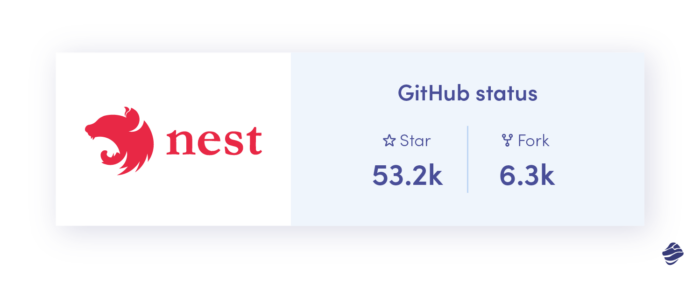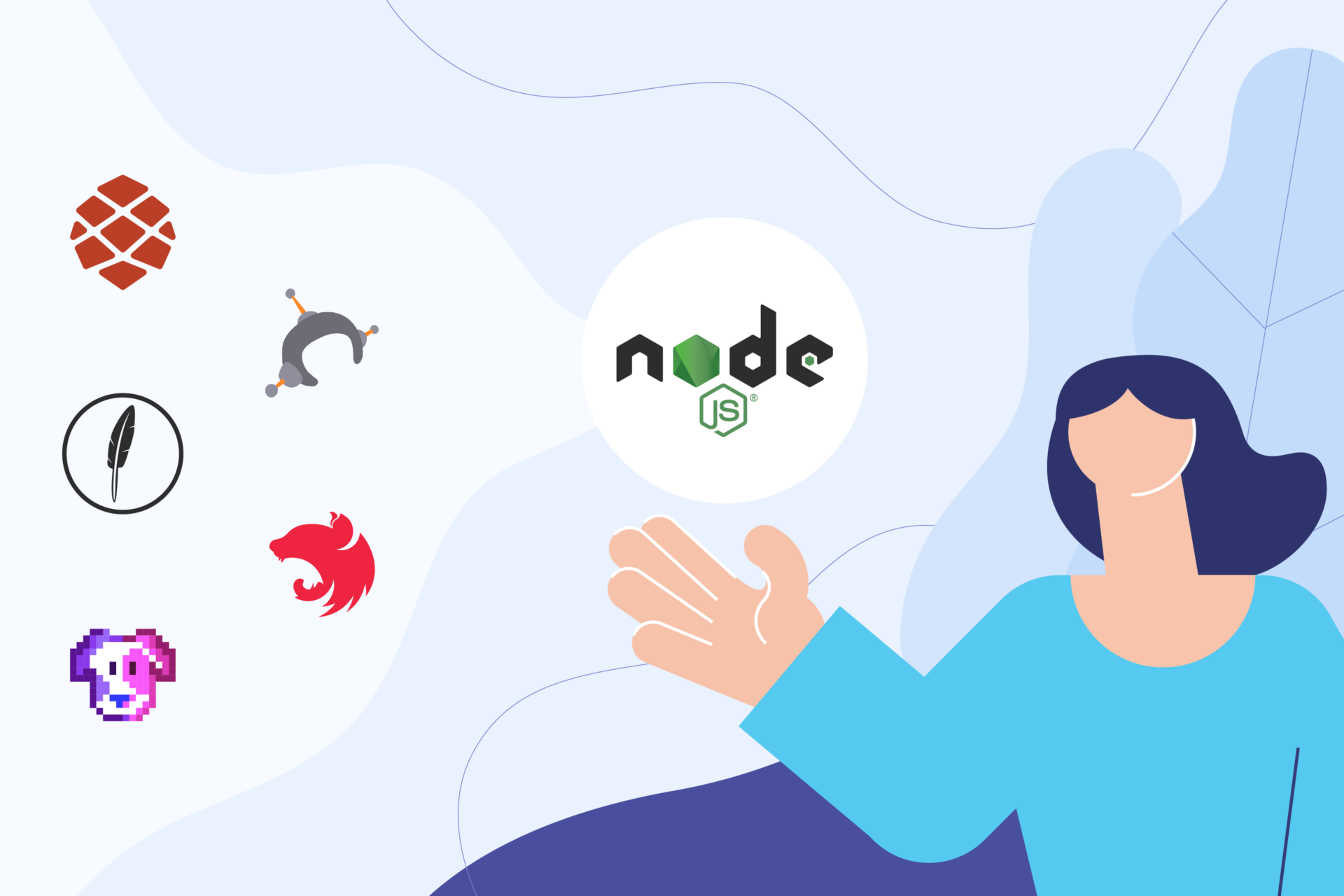If you are reading this article, you must be wondering which Node Js frameworks are worth paying attention to in 2023. Which Node Js framework will bring the desired optimisations and high performance in mobile and web app development? Which solution will meet your individual developer needs or improve your team’s work? So many questions and yet, even more answers!
You may have already skimmed a few other articles regarding top Node Js frameworks but for some reason, you still want to expand or organise your knowledge.
In this article, you will find a list of the best Node Js frameworks in 2023, based on reliable research, observation of market trends, and consultations with the backend dev team at Miquido. Ready? Let’s begin with an honest, real-life story.
My rocky road to choosing Node Js framework
I remember precisely when I first jumped into the JavaScript world almost eight years ago. From hard-typed, object-oriented programming language as C++ and C#, moving to quite the opposite environment was an extraordinary experience. I was in a place where perhaps you are now. Questions multiplied in my head, and all I got were ambiguous answers.
The more time I spent searching for good practice writing in JavaScript, the faster I understood that JavaScript is like a giant sandbox. What do I mean?

Whenever I wrote a feature, I wanted to compare it with someone else’s solution. The deeper I looked, the more doubts I had. Everyone (including me) had different approaches to problems they wanted to solve. I quickly realised JavaScript doesn’t have standards for code writing that could be useful for all platforms – and that’s completely normal. Backend developers need solutions different from frontend developers. Why?
Node Js frontend and backend frameworks
There is a fundamental difference between Node Js frontend and backend frameworks, resulting from different developer needs. Backend developers need more functionality in stdout logs instead of animation tools. In backend development, an easy way to manage SQL/NoSQL connection to the database is also much more important than a good CSS library. That’s why each platform has different frameworks applying to different developer needs. Indeed, there are some out-of-the-box bundle solutions – yet in most cases, there are separate Node Js frameworks for frontend and backend developers.
Different platforms, expectations, and a constant desire to optimise the software development process are the three main factors that make developers constantly test different Node Js frameworks. As a result, in 2023, there will be over 2 232 259 NPM modules tailored to the individual needs of developers and the specifics of their projects. How can you choose your perfect toolset from so many different solutions? Let’s find out!
How to choose the best Node Js framework for your project
How to choose the best Node Js framework for your project? It depends! Each Node Js framework responds to different needs – both of individual developers and businesses.
Choosing the right Node Js framework is a complex task. Your decision may depend on numerous factors, such as:
- State of the framework: You should always choose a framework still in maintenance to ensure support when needed.
- Community growth: A thriving community is a good indicator that suggests an active interest in the framework.
- Current issues: To prevent unexpected problems, check the GitHub issue page to see the most frequent troubles users are struggling with.
- Roadmap: A framework roadmap allows you to check if any important missing feature will be available over time.
- Documentation: A framework’s documentation must be readable, complete, and comprehensive. Good documentation is a time saver when you start your project using any framework.
You already know what aspects should be considered while choosing the Node Js framework. Now it’s time to take a closer look at the decision-making process.
Choosing the right Node Js framework for your project
Before you choose the Node Js framework, you should precisely define your criteria. You can use any methodology related to making technological or business decisions, such as a profit & loss statement, SWOT analysis, or any other decision matrix of your choice. Perhaps my tips below will also come in handy!
I’m a big fan of the saying, “start small, think big”. This universal rule can also be applied to choosing the Node Js frameworks. Don’t expect the first framework to meet all your team’s needs at once! Before starting a large-scale revolution in your company, test the solution thoroughly. Ensure you have time for consideration. Test, prototype, make mistakes, browse internet forums for answers, and search for alternatives when needed.
How to choose the right Node Js framework
- Prepare your technical and business requirements matrix.
- Compare your requirements with the available features of the framework. If something important is missing, check the roadmap to see if the feature will be available over time.
- Take time to test the chosen framework. You can also write a simple prototype to see how the framework works in real life.
Additional tips:
- You should spend more time building your features than completing repeatable tasks like API documentation (e.g., Swagger). A good framework should generate documentation automatically, saving you and your team a lot of time.
- Ask yourself: do you feel the architecture of this framework?
The most popular Node Js frameworks according to GitHub
Although popularity does not always go hand in hand with quality, it is often a good hint that helps us in the initial selection of Node Js frameworks. Here is a quick rundown of the most popular Node Js frameworks according to GitHub:

Curious about which Node Js frameworks from the GitHub ranking I picked for my personal list? Read on!
Top 5 Node Js Frameworks for 2023 picked by Backend Tech Lead
According to Module Counts, the average growth of NPM libraries is 1026 a day. I realise many of these libraries are simple tools, but from this in-month perspective, there are undoubtedly numerous new frameworks in over 30 000 packages. Given that incredible number, choosing the right Node Js framework for your team is not an easy task.
The most popular Node Js frameworks
Let’s begin with my choice of the most popular, and the most interesting Node Js frameworks, tested by our backend team at Miquido.
1. HAPI
Hapi.js is a scalable framework with minimal overhead and full out-of-the-box functionality – your code, your way.
Hapi.js

Hapi, or HTTP API, is an open-source framework for developing scalable and well-performing web apps. It’s worth mentioning that the framework has 100% code coverage across every dependency.
The creators of the Hapi.js framework are focused on quality and security. That’s why some modules, like Authentication, were written from scratch to ensure the individual approach. Because HAPI is an HTTP API, it provides a migration process from Express for new developers who want to use this framework.
When is Hapi.js the best choice? To ensure that you develop your project using a security-based framework by default, you should definitely try Hapi.js.
2. Nest.js
A progressive Node.js framework for building efficient, reliable and scalable server-side applications. A complete development kit for building scalable server-side apps.
Nest.js

Nest.js is a progressive Node.js framework created in 2017. The leading architecture was designed based on Angular and is a server-side application fully supported by TypeScript. It combines elements of OOP, FP and FRP programming.
The main idea of Nest.js is to provide an out-of-the-box application architecture that allows developers to create highly testable, scalable, and easily maintainable applications.
The framework uses (by default) Express HTTP Server but can be optionally configured to fully supported Fastify HTTP server.
Another advantage that speaks in favour of Nest is excellent documentation with basic tutorials, fundamentals, and recipes for most of the everyday use cases of backend HTTP API servers. That’s why over the years, the popularity of this framework has grown significantly.
Nest.JS has enterprise support, and there are many professional courses based on techniques used in this framework. A growing community of this framework from day-by-day puts this project at the top of popularity. According to job offers, we can observe that Nest.js is a framework increasingly required by companies for Node JS developers positions – which undoubtedly proves this framework’s versatility and overall high quality.
Full-Stack Node Js Frameworks
Many companies are searching for end-to-end frameworks containing all essential tools to build a web application. Full-stack Node Js frameworks allow developers to deliver stunning front-end UIs and reliable backend databases, ensuring equal, high technical standards for various teams in the company. Sounds convincing? Let’s find out which full-stack Node Js frameworks are worth a try!
1. Redwood
Redwood is an opinionated, full-stack, JavaScript/TypeScript web application framework designed to keep you moving fast as your app grows from side project to startup.
Redwood

Are you looking for a full-stack web app development framework based on modern technologies? Redwood should meet all your expectations!
Redwood is a full-stack framework based on React frontend integrated with GraphQL API at the highest level. The full-stack Node Js framework uses Prisma (Next-generation TypeScript ORM) to operate on a database. All features use Pino for logging and Jest for testing.
As a full-stack Node Js framework, Redwood is a perfect choice for everyone who doesn’t want to waste time on configurations. Settings up authentication or CSS Frameworks comes to single command line execution.
Redwood is the youngest solution in my Node Js frameworks review. The full-stack framework created by Tom Preston-Werner, a co-founder of GitHub, will be a great choice if you want to focus on your application features instead of configurations and integration of all of its parts.
2. Feathers
Feathers is a lightweight web framework for creating APIs and real-time applications with TypeScript or JavaScript.
Feathers

Feathers is a framework designed for interacting with any backend technology. Hence, it fully supports multiple databases. Architecture designed and integrated into this framework can be helpful whenever you want to focus on building your API and real-time application quickly.
Feathers provides the structure built for TypeScript to create complex applications, but it’s very readable and adjustable to focus on any feature you want to make.
(…) We wanted to build a framework that can grow with you as your product grows. One that is flexible enough to rapidly adapt to changing business needs, powerful enough to build modern apps, and simple enough to get up and running quickly.
Feathers started as a small library – but now it’s a mature framework allowing developers to build real-time applications and APIs in the most flexible and simple way. Curious about the philosophy behind creating Feathers? Be sure to read the article How FeathersJS came to be and why we built it by Eric Kryski, Creator of Feathers.
New Node Js frameworks now available on GitHub
Numerous new Node Js frameworks are released every month. Currently, frameworks that help developers optimise resource consumption and reduce marketing time are becoming increasingly popular. Let’s take a closer look at one exciting new solution I had the opportunity to test recently.
1. Hyperstack
Build more side projects, ship more products. Hyperstack is a modern Node.js web framework for the pragmatic programmer.
Hyperstack

Hyperstack is a perfect Node Js framework for optimising backend development processes, such as building apps, data modelling, or implementing app logic. Furthermore, Hyperstack, inspired by Rails, is an excellent tool for complex development teams – but it also provides everything a solo developer might need to build stable, secure web applications.
With Hyperstack, developers receive a complete package of valuable tools while also being able to disable every part they might not need. What is the most significant advantage of Hyperstack? It allows you to concentrate on your product instead of wasting time on advanced, time-consuming integrations. Perhaps that is the reason why it is so popular among solo developers and teams working on startup applications!
I saved the best for last! Hyperstack is a hackable framework allowing developers to customise and change code easily without explicit knowledge of the framework – so its the perfect choice for seasoned developers who value flexibility.
Are custom Node JS frameworks worth a try?
Of course, you can always choose in-house solutions to cover all your company’s needs. There are many reasons to do it and many more not to. At the beginning of this article, I mentioned that “time-consuming” was a reason to search for a framework for future projects, but I know perfectly well that in-house solutions never end on their creation. Why?
Support, bug fixing, and technology debt that must be covered over time are just a few reasons you should think twice before developing an in-house solution. On the other hand, if you have done your research and still haven’t found a Node Js framework that suits your needs, consider opting for a custom-made one.
Sometimes spending more time at the beginning of the project might allow you to save time later. After all, there is nothing worse than a framework that requires constant workarounds.
How did we choose the best Node Js framework at Miquido?
As a Backend Tech Lead at Miquido, I deeply care about code quality. When creating a project for our client, there is no room for shortcuts, code deficiencies, and accumulation of technical debt. While searching for a Node Js framework for Miquido, we needed a high-quality, uniform approach that would work in the various projects we could create – from MVPs for startups to large commercial applications for the banking industry.
My first thought was the need for standardisation of the codebase. I never want to be in a situation where projects written in Miquido get deleted because of a different approach to its architecture and codebase solutions. That’s why we started seeking a flexible solution that could work both for complicated and straightforward projects.
At Miquido, we create Node JS solutions using Nest.JS Framework. With the impressive help of the framework community, excellent communication with its authors, and the framework’s stability, we have successfully completed over 250 projects – now used by millions of users around the world.







